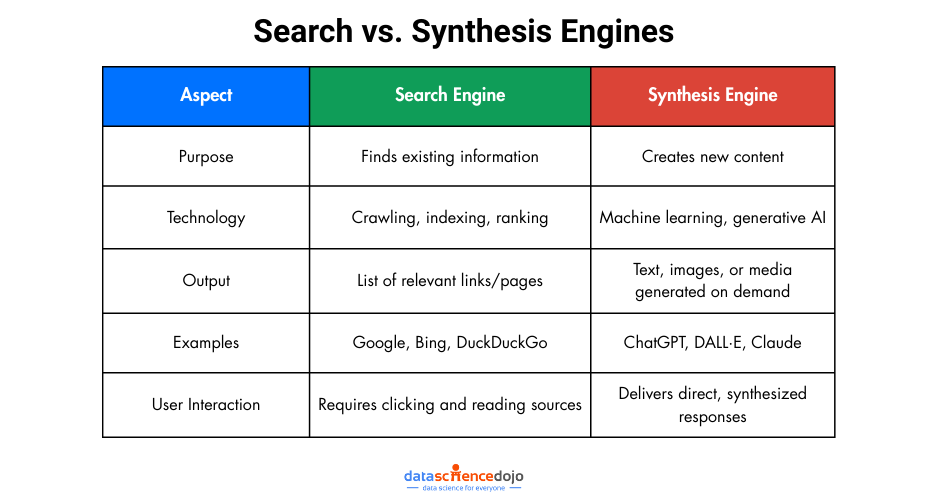The way we search for information is changing. In the past, we would use search engines to find information that already existed. But now, with the rise of synthesis engines, we can create new information on demand.
Search engines and synthesis engines are two different types of tools that can be used to find information. Search engines are designed to find information that already exists, while synthesis engines are designed to create new information.
The topic of engines has been attracting increasing attention for some time. The question of which type of engine is better depends on your specific needs. Let’s delve into the blog to learn more about this topic.
Search Engines
Search engines operate as powerful digital librarians, helping users navigate the vast expanse of information available on the internet. Their primary function is to locate and retrieve content that has already been published. This is made possible through a process known as web crawling, where automated bots (also called spiders) systematically explore web pages, follow links, and collect data.
Once the content is discovered, it’s indexed—meaning it’s categorized and stored in massive databases using keywords, metadata, and contextual clues. This index allows the search engine to rapidly pull up relevant results the moment a user enters a query. The algorithms behind the scenes then analyze the search term, compare it to the indexed content, and rank the results based on factors like relevance, quality, freshness, and user engagement.
In essence, search engines don’t “understand” the content in a human sense—they match patterns, keywords, and ranking signals to serve up the best-matching pages. Their strength lies in speed and breadth, making them ideal for quick lookups, fact-checking, or accessing widely available information from trusted sources.
Here are some of the most popular search engines:
- Bing
- Yahoo!
- DuckDuckGo
- Ecosia
Synthesis Engines
Synthesis engines represent a new frontier in how we interact with information. Unlike tools that simply retrieve existing content, synthesis engines are built to generate entirely new outputs. They do this by leveraging machine learning models, particularly those trained on large and diverse datasets. These models learn patterns, relationships, and structures in language, visuals, or behavior, allowing them to produce original content in response to a prompt.
Rather than pulling from a database of prewritten answers, synthesis engines construct responses in real-time—tailoring them to the context, tone, and intent of the user. This makes them incredibly versatile, capable of composing articles, designing images, scripting code, or summarizing complex documents.
A key advantage of synthesis engines lies in their ability to draw insights from data. For instance, given a dataset of customer preferences and behavior, they can generate targeted ad copy, personalized product recommendations, or even suggest improvements to a brand’s messaging strategy. Similarly, in journalism, they can automate the drafting of news reports based on real-time data, such as financial trends or sports statistics.
In short, synthesis engines aren’t just processing data—they’re transforming it into meaningful, customized content that adds value far beyond what’s already available online.
Here are some of the most popular synthesis engines:
- GPT-3
- Jarvi
- LaMDA
- Megatron-Turing NLG
- Jurassic-1 Jumbo
There are some benefits of using synthesis engines like how they can generate new information on demand. This means that you can get the information you need, when you need it, without having to search for it. They can be used to create a variety of content. They can be used to generate text, images, videos, and even music. This means that you can use them to create a wide range of content, from blog posts to marketing materials.
Plus, they can be used to personalize content. They can be used to personalize content based on your interests and needs. This means that you can get the most relevant information, every time.
Of course, there are also some challenges associated with using synthesis engines like they can be expensive to develop and maintain. This means that they may not be accessible to everyone. Plus, they are trained on data that is created by humans. This means that they can be biased, just like humans.
Differences Between Search Engines and Synthesis Engines
A search engine is designed to help users find existing information across the internet. It works by crawling websites, indexing content, and ranking results based on relevance. When you type a query into Google or Bing, it returns a list of web pages that match your search terms.
These engines rely on structured data, metadata, and algorithms like PageRank to decide which links are most useful. However, they don’t generate content — they simply point you to where it already exists.
A synthesis engine, on the other hand, is built to generate new content using machine learning. These tools analyze large volumes of data and produce text, images, or other forms of output based on user prompts. Instead of just finding information, they create it.
Examples include tools like ChatGPT for text, DALL·E for images, and other AI-powered platforms that can draft emails, summarize reports, or even design logos. Synthesis engines are especially powerful for content creation, personalization, and automation.
Key Differences at a Glance

When to Use Each
-
Use search engines when you want to explore different sources, compare opinions, or find factual information.
-
Use synthesis engines when you need tailored content, creative outputs, or fast summarization of complex data.
This evolving landscape highlights how AI is not just helping us access knowledge faster but also shaping how that knowledge is produced. As synthesis engines continue to improve, the line between discovering and creating information is becoming increasingly blurred.
Deciding Which One is Better for Search
While both search engines and synthesis engines are designed to help users access information, they differ significantly in how they do it and the depth of insights they can provide.
Search engines excel at retrieving specific pieces of information from the web. They’re fast, efficient, and perfect for users who know exactly what they’re looking for — whether it’s a statistic, a tutorial, or a product review. However, their limitations lie in the fact that they can only show what already exists online. They do not interpret, combine, or expand on that information.
On the other hand, synthesis engines go a step further. Instead of just finding data, they analyze and generate new insights. These engines use advanced algorithms and large datasets to identify patterns, infer meaning, and present synthesized content — often revealing connections that humans might miss.
A practical example of this difference can be seen in medical research. A search engine can quickly surface journal articles or clinical trial reports based on keywords. But a synthesis engine can analyze thousands of such studies, extract patterns, and potentially suggest novel hypotheses or treatment options based on correlations across datasets — speeding up discovery and decision-making.
Conclusion
In conclusion, both search engines and synthesis engines have their strengths and weaknesses. Search engines are great for finding specific information quickly, while synthesis engines are better suited for generating new insights and connections between data points.
In the future, we can expect to see a continued shift toward synthesis engines. This is because synthesis engines are becoming more powerful and easier to use. As a result, we will be able to create new information on demand, which will change the way we work, learn, and communicate.





